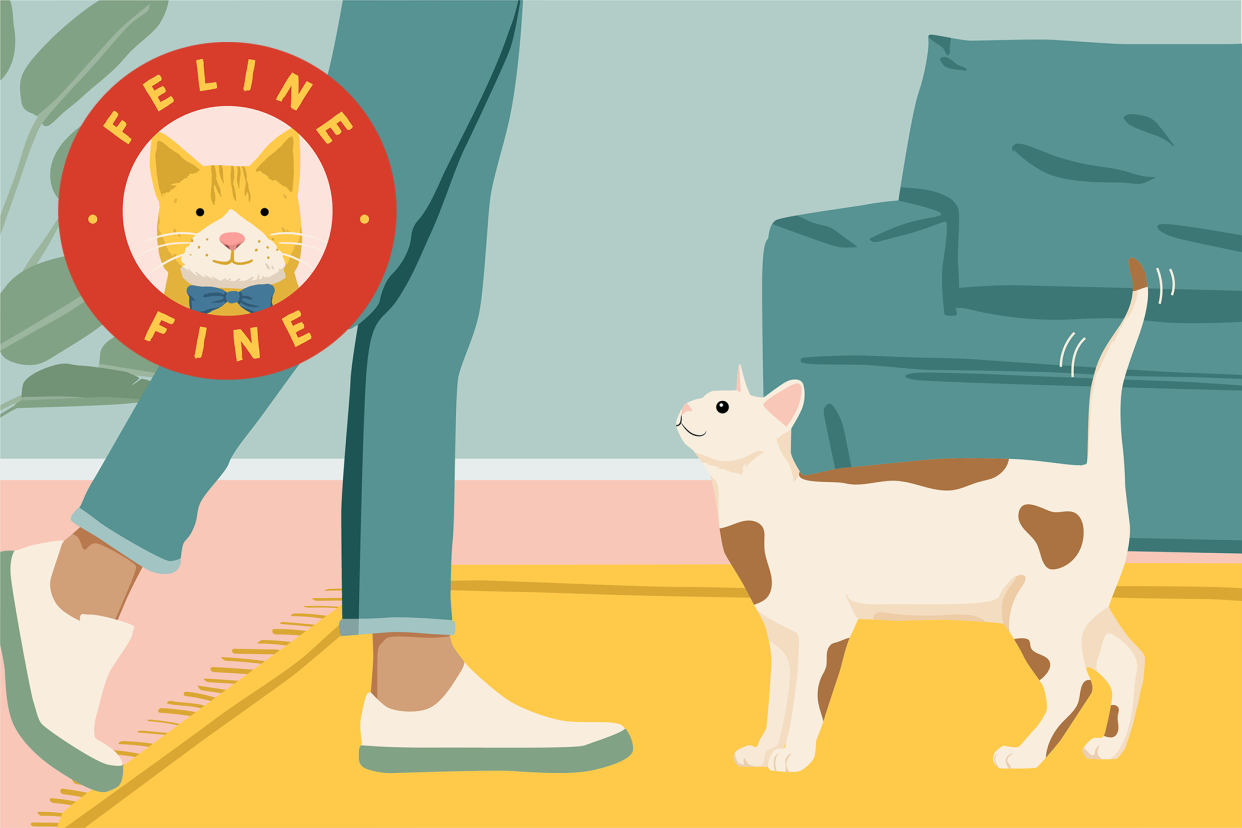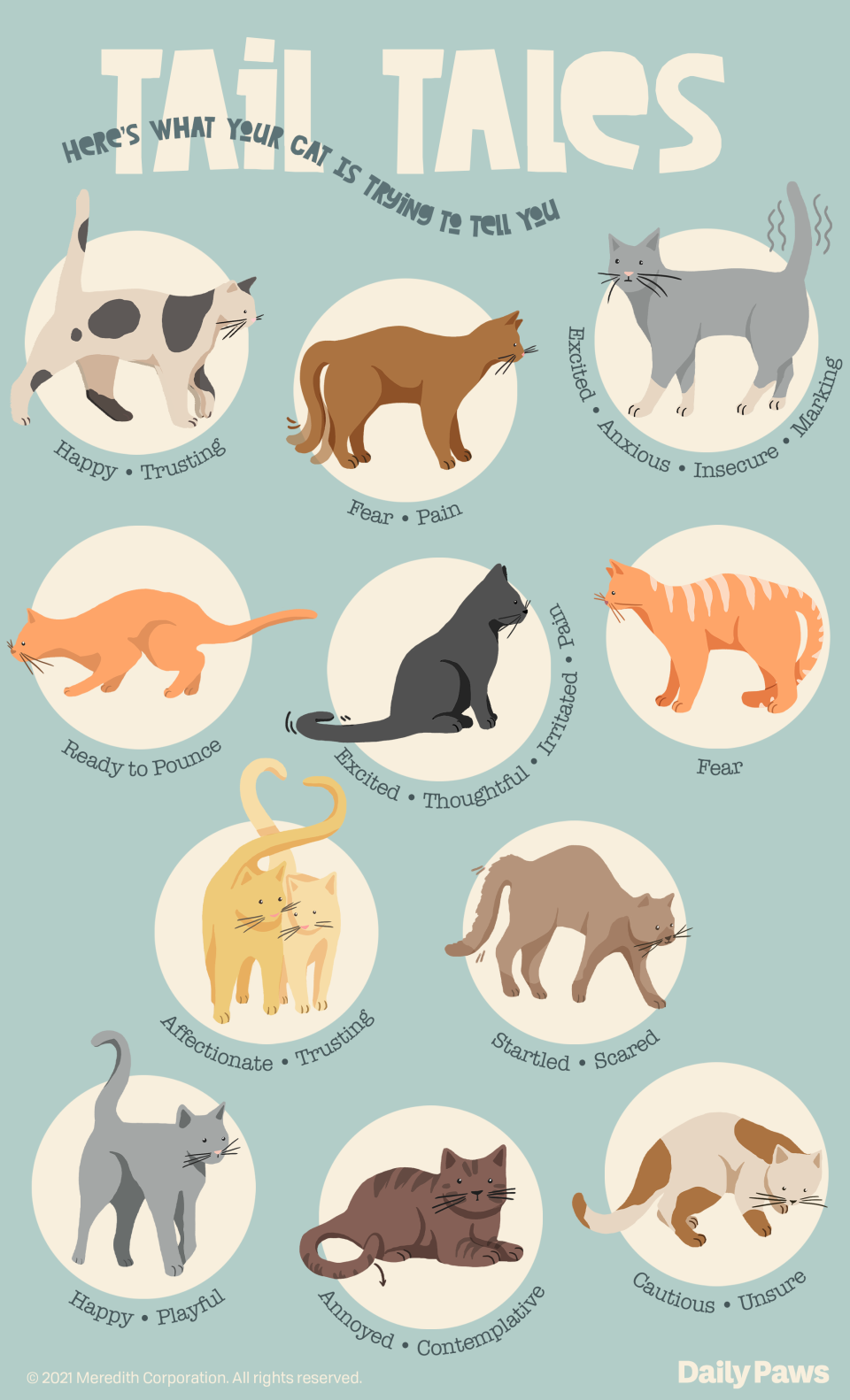Why Do Cats Wag Their Tails? Here's What Your Feline Is Trying to Tell You

Emma Darvick
Cats can seem as mysterious as the Mona Lisa because their faces reveal very little about their emotions. But your cat's tail is another story. Each swish, shake, and wag reveals how he's feeling, how to meet his needs, and what to expect next.
Do Cats and Dogs Communicate Differently?
Like dogs, cats use their tails to communicate. However, cats can sometimes send mixed messages because their tail movements cover a wide range of emotions. "A lot of people think cats are mysterious and aloof but, in reality, it's just in their nature to conceal their emotions," says Molly DeVoss, Certified Feline Training and Behavior Specialist for Cat Behavior Solutions in Dallas.
"Dogs have evolved with a social hierarchy that differs from cats. Dogs view their owners as pack leaders and, thus, try to please them. This often includes mimicking happy expressions that make you smile," DeVoss says. "But cats have evolved as a solitary species. In the wild they live alone, not with other cats, so they have little need for communication."
DeVoss says that when cats communicate with one another in the wild, it revolves around territorial and mating gestures. In those situations, revealing their emotions might be interpreted as a sign of weakness, so cats use a silent form of communication—their tails. This is true of domestic cats, too, who are known for their "poker face," especially when compared to dogs who are much more expressive.
Cat body language is fascinating to watch, yet complicated to understand. To accurately "read" your cat, DeVoss recommends considering his tail and overall body position, plus his activity and surrounding environment at the time. Put the pieces together—like a puzzle—for the context needed to decode your cat's language, meet your feline friend's needs, and strengthen your bond with him.
RELATED: 8 Tips to Get Any Cat to Like You More
11 Ways Cats Wag Their Tails and What They're Trying to Communicate
When your cat talks with their tail, take heed. While you should always look at total body language and the immediate environment your cat is in to get a full picture of what they're feeling, these are some common emotions your cat could be communicating with their tail.

Kailey Whitman
1. Straight Up Tail
A cat's tail often pops straight up when they're walking in an environment where they feel confident. When approaching other cats with whom they have a friendly relationship, it's also a sign of trust and a desire to engage.
2. Wagging Tail
Dogs wag their tails to show they're happy, but not cats. In fact, a cat's wagging tail usually means exactly the opposite. If two cats wag their tails at one another while their backs are arched and their heads are lowered they may be about to engage in a skirmish. However, a constantly wagging tail may also indicate that your cat is in pain.
3. Tail Shiver or Shudder
Your cat is excited, marking his territory, or is feeling stressed, anxious, or insecure if his tail shivers or shudders.
4. Tail Straight Out and Rigid
When your cat is crouched and ready to pounce, his tail goes straight out and rigid so it can be used as a balancing tool when making quick turns or jumping.
5. Flicking or Swishing Tail
A flicking tail or side-to-side swish indicates excitement, contemplation, beginning irritation, or that your cat is in pain. This could also mean your cat is focused, such as when watching a bird outside the window.
6. Tucked Tail
A tucked tail could be a sign of fear or pain.
7. The Tail Wrap
When your cat wraps his tail around you or drags his tail over you, it's an affectionate, trusting gesture similar to humans holding hands or putting an arm around someone. Bonded cats will frequently walk with their tails entwined or will relax together that way.
8. Puffed Out Tail
If the hair on your cat's tail puffs out and his body arches (think Halloween cat silhouette), he's been startled by something and is really scared.
9. Question Mark Tail
When the tip of your cat's tail forms the shape of a question mark, it means he's happy or in a playful mood. It is also a way cats who are friends will commonly greet each other.
10. Tapping Tail
When your cat is in a relaxed position and tapping the end of his tail, it means he's slightly annoyed or contemplating something. Like "I'm trying to sleep and that sound is bothering me," or "My tummy is grumbling," or "I'm thinking about getting up to go to the litter box, but I'm so sleepy."
11. Lowered Tail
The lower the tail, the more cautious or unsure your cat is feeling.
RELATED: Why Do Cats Rub Against You?

